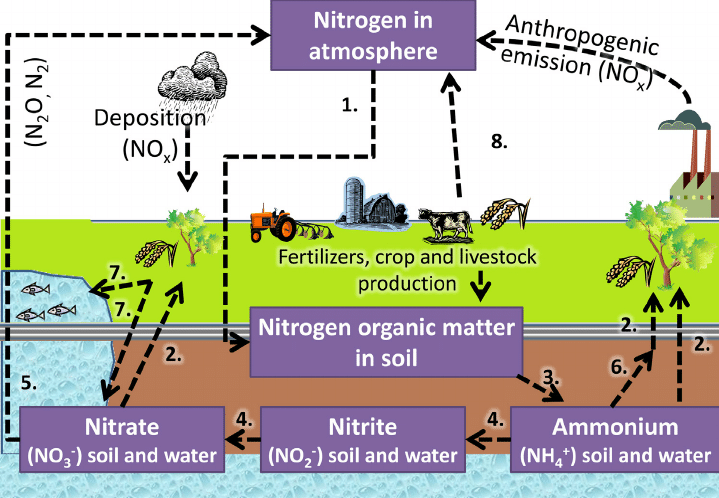
noun
- the continuous sequence of events by which atmospheric nitrogen and nitrogenous compounds in the soil are converted, as by nitrification and nitrogen fixation, into substances that can be utilized by green plants, the substances returning to the air and soil as a result of the decay of the plants and denitrification.
noun
- the natural circulation of nitrogen by living organisms. Nitrates in the soil, derived from dead organic matter by bacterial action, are absorbed and synthesized into complex organic compounds by plants and reduced to nitrates again when the plants and the animals feeding on them die and decaySee nitrification, nitrogen fixation
n.
- The circulation of nitrogen in nature, consisting of a cycle of chemical reactions in which atmospheric nitrogen is compounded, dissolved in rain, and deposited in the soil, where it is assimilated and metabolized by bacteria and plants, eventually returning to the atmosphere by bacterial decomposition of organic matter.
- carbon-nitrogen cycle
- The continuous process by which nitrogen is exchanged between organisms and the environment. Nitrogen is an essential nutrient, needed to make amino acids and other important organic compounds, but most organisms cannot use free nitrogen, which is abundant as a gas in the atmosphere. Gaseous nitrogen is broken apart and fixed (converted to stable, biologically assimilable inorganic compounds) in the process of nitrogen fixation. Some atmospheric nitrogen is fixed naturally during lightning strikes and some by industrial processes. Cyanobacteria and certain other species of bacteria, especially those living as symbionts in the roots of legumes, fix atmospheric nitrogen biologically in ammonium ions. Ammonia and ammonium ions are also produced by the ongoing decay of organic materials. Ammonia can be absorbed directly by plant cells, and certain bacteria living in soil and water convert ammonia and ammonium ions into nitrites and nitrates in the process known as nitrification. The nitrates are easily absorbed by plant roots. In this way, nitrogen is passed into the food chain and ultimately returned to the soil, water, and atmosphere by the metabolism and decay of plants and animals.
 Liberal Dictionary English Dictionary
Liberal Dictionary English Dictionary